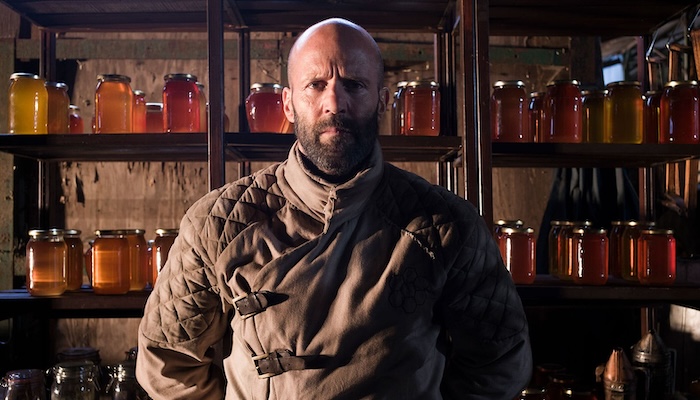Film Review: THIRD PERSON: All Fair in Love & Work [TFF 2014]
Third Person (2013) Film Review from the 13th Annual Tribeca Film Festival (TFF). A movie written & directed by Paul Haggis and starring Liam Neeson, Olivia Wilde, Adrien Brody, Maria Bello, Mila Kunis, James Franco, Moran Atias and Kim Basinger.
Let me say, up front, that I consider myself a fan of Paul Haggis. I don’t say this as a caveat, I merely wish to add a bit of preemptive context to how I went into Third Person, and what I took away from it. As a character study involving an ensemble cast, across multiple separate, yet inter-connected stories, comparisons will inevitably be made to Haggis’ award winning Crash. That saves me the trouble. It also allows me to mention Haggis’ penchant for springing surprise turns, on both his characters, and the viewer, alike. He also has an ear for music; so when Dario Marianelli‘s score was added to the visuals of the opening scene, a case seemed to be made. Something heavy was coming.
Of course, the destination should never render the journey irrelevant, before arrival. Third Person took its viewers to that something by way of three separate, yet inter-connected tales.
The Wolf & The Fox
Pulitzer winning author Michael (Liam Neeson), in mid-labor with his latest work, invited Anna (Olivia Wilde) to fly to Paris, and his hotel suite writer’s redoubt. They were clearly lovers, but the reunion marked the beginning of a series of coy game play – and it’s just as well. Anna was a beautiful creature – almost literally. A wild, temperamental, wary, and vicious wolf in designer clothing. Michael, however, was just clever and clear headed enough to keep a step ahead of her, and keep her interested. The fox to her wolf. The trouble lay in the nature of these two creatures. Wolves are social – a lone wolf is subject to any number of dysfunctional tendencies, and everything is a threat; foxes have singular relationships, but are geared to survive loss – to a lone fox, everything is an opportunity.
Olivia Wilde fit her role quite well. She projects a presence behind her striking features – and even more striking eyes – that looms much larger than the sum of her parts. In this case, she opted to project a creature of bad habit, driven by fear & loathing, and a need for strings-free fun. I’d say it was a smooth transition. Liam Neeson has dabbled in various genres, but played to his strength, here, as the understated father figure; careful to make his character as helpless as he was all-powerful, in the greater scheme of things. While this portrayal was aided by its sharp contrast to Wilde’s extremes, it was complimented by an even more understated performance by Kim Basinger, as his estranged wife.
A Game of Long Cons
Alternating between tonal opposites, like comedy & tragedy, could be considered the sweet & sour flavor of storytelling; so when a shady American (Adrien Brody), as a fish out of water in Rome, walked into an “American” bar, only to find himself further out of his element, the irony set the stage for some cross-cultural hi-jinx. A hard to miss entrance, by a hard to ignore femme fatale (Moran Atias), however, made it easier for the “ugly American” to find his inner messiah’s complex. Or so it seemed. The mismatched couple provided Third Person with some of its lighter moments; but also plumbed some of its seedier depths. When two people are so far beyond what meets the eye, they become uniquely qualified to judge each other by the covers. What remained, once these two each committed to play the other’s game, was seeing who takes it furthest, and what could be salvaged from it. Confidence games don’t just rely on trust, they rely on the hopes that such trust bear fruit. Trust is most often resorted to by those who need to know they can still afford to trust. That level of neediness was to be a literal pivot point for the film, as a whole.
Brody has done well, playing both the saint and the sinner, but I didn’t quite buy him as both, simultaneously. Likewise, Moran Atias came across as a Latin stereotype: all high-maintenance and an emotional mine field. The sub-plot itself was ridiculous, and its outcome laughably storybook. The thing is, none of that mattered. More importantly, the credibility gaps to their sub-plot served a clear purpose to the larger film.
Between a Bear & Her Cub
In NYC, Julia (Mila Kunis) had her world collapse around her, and things got worse from there. Her inability to handle a critical moment, involving her son, cost her custodianship; but her inability to manage this, as an ongoing crisis, may cost her any remaining visitation rights. It also strained relations with the one person left in her corner, Theresa (Maria Bello), the attorney trying to secure her a positive psyche evaluation. For all her desperation, however, the lengths to which she was willing to go, in order to see her son, might have been over matched by her ex, Rick’s (James Franco), determination to be rid of her. Their direct confrontation could have easily been the most heart wrenching moment of the film; but it was still just a piece to a puzzle.
Mila Kunis made Julia the most memorable of the supporting characters, depicting her as someone as much a victim of her own emotions, as a victim of circumstance. Franco took the opposite tact, creating a character emotionally detached enough to serve as the rocks Julia’s tide breaks against. Loan Chabanol, as Rick’s girlfriend, Sam, brought an interesting dynamic to the sub-plot. Torn between her sympathies for Julia, as a broken down stranger, and her ties to Rick and his son, Sam would be rendered a moot point, when the second shoe finally dropped. As little more than a helpless witness, I suppose that made Sam something of a stand-in for the viewing audience. However we might react to onscreen events, as they unfold, we have to wait to see what comes of them, in the larger context.
All of these stories were connected by a singular theme. Although only two were upfront about it, all three revolved around how the loss, or prospective loss of a child affected the characters, their actions, and their interactions with each other. There was also a common thread in how occupational hazards/ preoccupation kept getting in the way of resolving these. Something else all three tales had in common: they featured one or more sociopaths. Sociopaths rarely make for good protagonists, but they do make for good redemption tale material (As Good As it Gets comes to mind). They make for even better villains; and the best villains are the ones you never see coming.
As the three stories progressed separately, the credibility gap began to widen, in certain places. When universal issues between them were directly addressed, however, the true connection, between all three stories, became clear with a redressing of the film’s components. Where that connection could serve as the major plot twist, to most any other ambitious would-be mind-bender, Haggis managed to use it as a mere set-up for the film’s true revelations of plot and character.
This may have very well been the signature of Third Person. There seemed to be a deliberate effort to provide obvious insights and oversights, in order to allow more subtle ones to slip by, unnoticed. A slight of hand worthy of the film’s two professional con artists; but of course, their segment may well have been a long con in-of-itself. Even the film’s most forced & contrived moments are redeemed by its larger context. To Haggis’ credit, he never tried to really conceal any of this, and the ending was given away in a single scene, that could be considered a throwaway. It won’t take a genius to see some of the glaring continuity/ setting slips & missteps; but slight of hand relies on a measure of observation skill. The real challenge will be in figuring out who all these characters were, what their stories represented, and, ultimately, how far the foremost sociopath was willing to go to overcome them all.
Something heavy did come. It may take a particularly cynical viewer to anticipate what that coming something was; but for those who do, I doubt the sense of vindication would be described as satisfying. Personally, I dreaded the outcome, and found a certain sadistic quality in how Third Person‘s characters were utilized. Context is everything, however, and in the context of the ultimate sociopath’s goal & motives, it all made sense, unpleasant or not.
Rating: 7/10
Leave your thoughts on Third Person and this review below in the comments section. For more Third Person photos, videos, and information, visit our Third Person page, subscribe to us by Email, “follow” us on Twitter, Tumblr, and “like” us on Facebook.
Related Articles
FilmBook's Newsletter
Subscribe to FilmBook’s Daily Newsletter for the latest news!













